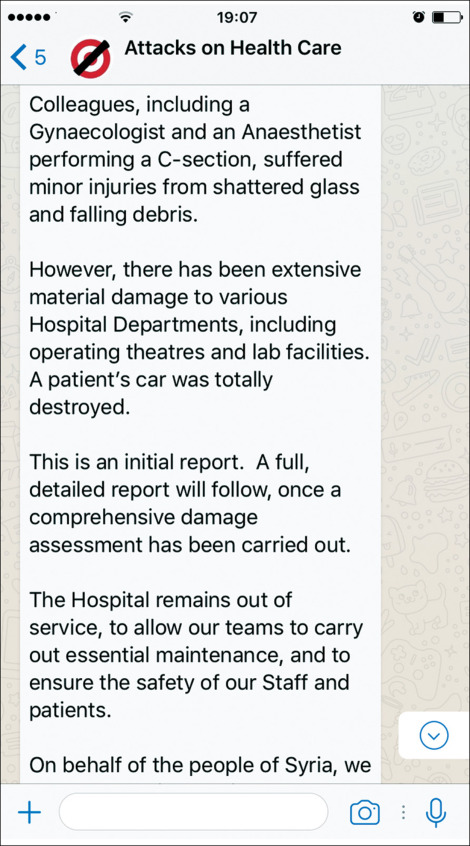The Lancet ( IF 98.4 ) Pub Date : 2017-06-08 , DOI: 10.1016/s0140-6736(17)31328-4 Mohamed Elamein , Hilary Bower , Camilo Valderrama , Daher Zedan , Hazem Rihawi , Khaled Almilaji , Mohammed Abdelhafeez , Nabil Tabbal , Naser Almhawish , Sophie Maes , Alaa AbouZeid

|
Background
Collecting credible data on violence against health services, health workers, and patients in war zones is a massive challenge, but crucial to understanding the extent to which international humanitarian law is being breached. We describe a new system used mainly in areas of Syria with a substantial presence of armed opposition groups since November, 2015, to detect and verify attacks on health-care services and describe their effect.
Methods
All Turkey health cluster organisations with a physical presence in Syria, either through deployed and locally employed staff, were asked to participate in the Monitoring Violence against Health Care (MVH) alert network. The Turkey hub of the health cluster, a UN-activated humanitarian health coordination body, received alerts from health cluster partners via WhatsApp and an anonymised online data-entry tool. Field staff were asked to seek further information by interviewing victims and other witnesses when possible. The MVH data team triangulated alerts to identify individual events and distributed a preliminary flash update of key information (location, type of service, modality of attack, deaths, and casualties) to partners, WHO, United Nations Office for the Coordination of Humanitarian Affairs, and donors. The team also received and entered alerts from several large non-health cluster organisations (known as external partners, who do their own information-gathering and verification processes before sharing their information). Each incident was then assessed in a stringent process of information-matching. Attacks were deemed to be verified if they were reported by a minimum of one health cluster partner and one external partner, and the majority of the key datapoints matched. Alerts that did not meet this standard were deemed to be unverified. Results were tabulated to describe attack occurrence and impact, disaggregated where possible by age, sex, and location.
Findings
Between early November, 2015, and Dec 31 2016, 938 people were directly harmed in 402 incidents of violence against health care: 677 (72%) were wounded and 261 (28%) were killed. Most of the dead were adult males (68%), but the highest case fatality (39%) was seen in children aged younger than 5 years. 24% of attack victims were health workers. Around 44% of hospitals and 5% of all primary care clinics in mainly areas with a substantial presence of armed opposition groups experienced attacks. Aerial bombardment was the main form of attack. A third of health-care services were hit more than once. Services providing trauma care were attacked more than other services.
Interpretation
The data system used in this study addressed double-counting, reduced the effect of potentially biased self-reports, and produced credible data from anonymous information. The MVH tool could be feasibly deployed in many conflict areas. Reliable data are essential to show how far warring parties have strayed from international law protecting health care in conflict and to effectively harness legal mechanisms to discourage future perpetrators.
Funding
None.
中文翻译:

2015-16年叙利亚对卫生保健的袭击:实时报告工具的结果
背景
收集有关战区针对卫生服务,卫生工作者和患者的暴力行为的可靠数据是一项巨大的挑战,但对于了解违反国际人道主义法的程度至关重要。我们介绍了一种自2015年11月以来主要在叙利亚境内有武装反对派团体大量存在的地区使用的新系统,用于检测和验证对医疗服务的攻击并描述其影响。
方法
通过部署和当地雇用的员工,所有在叙利亚设有办事处的土耳其卫生小组组织都被要求参加“针对医疗保健的暴力监测”(MVH)警报网络。卫生小组的土耳其枢纽是联合国启动的人道主义卫生协调机构,它通过WhatsApp和匿名的在线数据输入工具从卫生小组合作伙伴那里收到警报。要求外勤人员在可能的情况下与受害者和其他证人进行面谈,以寻求进一步的信息。MVH数据团队对警报进行了三角剖分,以识别单个事件,并向合作伙伴,世界卫生组织,联合国人道主义事务协调局,和捐助者。该小组还从几个大型非卫生部门组织(称为外部合作伙伴)接收并输入了警报,这些组织在共享信息之前先进行自己的信息收集和验证过程。然后,在严格的信息匹配过程中对每个事件进行评估。如果至少有一个健康集群伙伴和一个外部伙伴报告了攻击,则认为这些攻击已得到验证,并且大多数关键数据点都匹配。不符合此标准的警报被视为未经验证。将结果汇总成表格以描述攻击的发生和影响,并在可能的情况下按年龄,性别和位置进行分类。然后,在严格的信息匹配过程中对每个事件进行评估。如果至少有一个健康集群伙伴和一个外部伙伴报告了攻击,则认为这些攻击已得到验证,并且大多数关键数据点都匹配。不符合此标准的警报被视为未经验证。将结果汇总成表格以描述攻击的发生和影响,并在可能的情况下按年龄,性别和位置进行分类。然后,在严格的信息匹配过程中对每个事件进行评估。如果至少有一个健康集群伙伴和一个外部伙伴报告了攻击,则认为这些攻击已得到验证,并且大多数关键数据点都匹配。不符合此标准的警报被视为未经验证。将结果汇总成表格以描述攻击的发生和影响,并在可能的情况下按年龄,性别和位置进行分类。
发现
在2015年11月上旬至2016年12月31日之间,在402起针对医疗保健的暴力事件中,有938人直接受伤:677人(72%)受伤,261人(28%)被杀。死亡的大多数是成年男性(68%),但是在5岁以下的儿童中,病死率最高(39%)。24%的袭击受害者是卫生工作者。在主要有武装反对派团体的主要地区,约有44%的医院和所有基层医疗诊所的5%遭受袭击。空中轰炸是攻击的主要形式。三分之一的医疗保健服务遭受了不止一次的打击。提供创伤护理的服务比其他服务受到的打击更大。
解释
本研究中使用的数据系统解决了重复计数问题,减少了可能产生偏差的自我报告的影响,并从匿名信息中获得了可信的数据。MVH工具可以在许多冲突地区可行地部署。可靠的数据对于显示交战各方与保护冲突中的医疗保健的国际法有多大距离,以及有效利用法律机制来阻止未来犯罪者至关重要。
资金
没有任何。











































 京公网安备 11010802027423号
京公网安备 11010802027423号